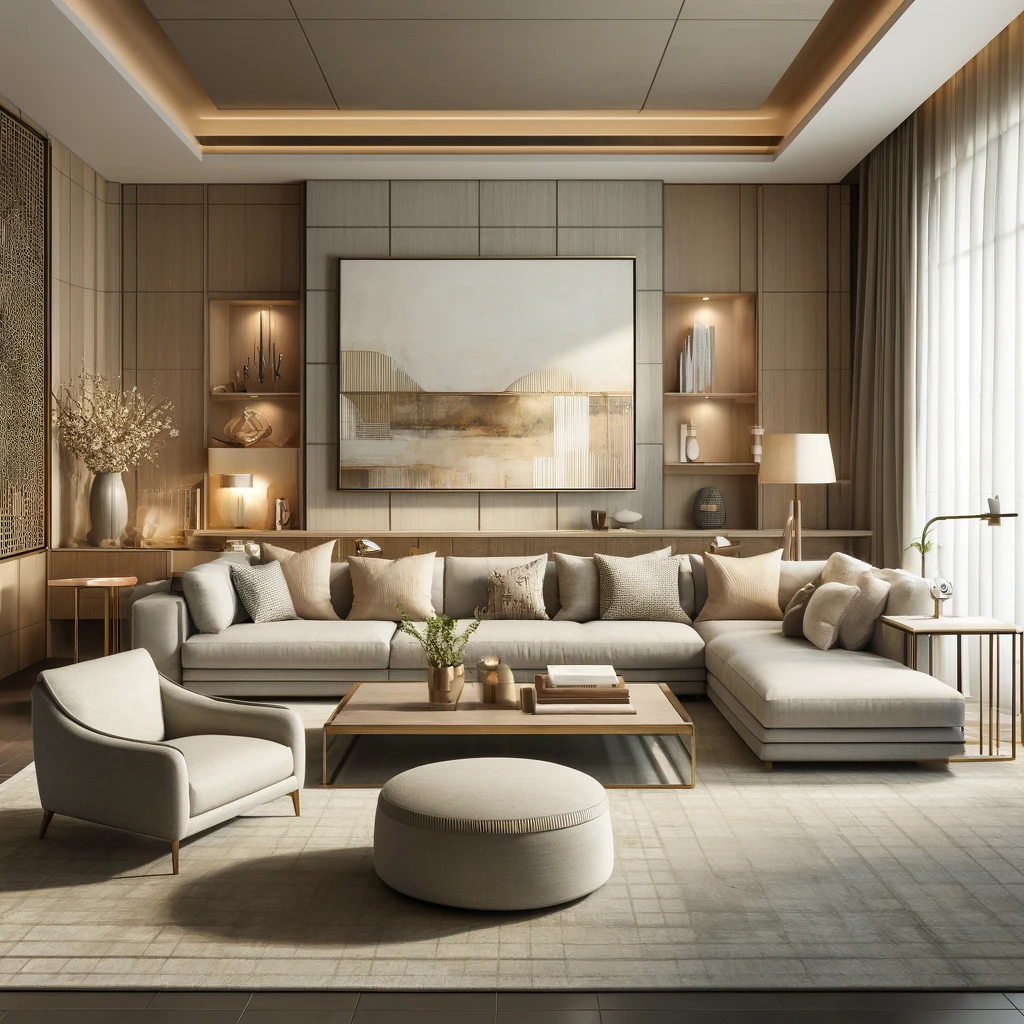Physical Address
304 North Cardinal St.
Dorchester Center, MA 02124


Home-style furniture is not just about filling spaces in your living area; it’s about creating a vibe, a feeling that speaks volumes about your personal taste and lifestyle. It’s about making a statement without saying a word. This guide delves into the essence of home-style furniture, emphasizing its pivotal role in home aesthetics and personal style expression. Let’s embark on a journey through the world of furniture, exploring its influence on home aesthetics and identifying trending styles that could define modern home décor.
Home-style furniture goes beyond the basic need for comfort; it’s an art form that reflects the soul of your home. Imagine walking into a room and feeling a wave of peace, excitement, or inspiration wash over you. That’s the power of well-chosen furniture. It’s not just about the material or the color; it’s about the story each piece tells and how it complements the overall theme of your home.
Choosing the right furniture is akin to selecting the right ingredients for a recipe. Each piece adds a unique flavor, and when blended together, they create a masterpiece that’s both inviting and expressive. From the minimalist charm of Scandinavian designs to the rustic warmth of farmhouse styles, furniture can transport you to different worlds, all within the confines of your home.
Selecting the right furniture is crucial for several reasons. First, it significantly impacts the functionality of your space. The right furniture not only serves its purpose but also maximizes space efficiency, making your home feel more spacious and organized.
Secondly, furniture plays a key role in setting the mood and ambiance of your home. A cozy, plush sofa invites relaxation and family gatherings, while a sleek, modern desk can inspire creativity and productivity. The choices you make can enhance your daily life, providing comfort and motivation in every corner.
Moreover, selecting furniture that reflects your personal style is essential for creating a space where you feel truly at home. It’s an expression of your individuality and a testament to your design sensibilities. When your home reflects your personal style, it becomes a sanctuary, a place where you can be your true self.
The influence of furniture on home aesthetics cannot be overstated. It’s the cornerstone of interior design, the element that ties everything together. The right furniture can elevate a room from ordinary to extraordinary, creating a cohesive look that exudes elegance and harmony.
Color, texture, and form play integral roles in achieving the desired aesthetic. A monochromatic theme can be soothing and sophisticated, while bold, vibrant pieces can add energy and vitality to a space. The textures of your furniture, from the smoothness of leather to the softness of velvet, add depth and dimension, making your home feel more inviting.
Furniture also defines the flow of a room, guiding movement and drawing attention to focal points. A well-placed armchair or a striking coffee table can become a conversation starter, creating a focal point that adds character and interest to your space.
Keeping up with trending styles can inspire you to refresh your space and incorporate elements that add a contemporary touch to your home. Some of the current trends in home décor include:
Identifying your personal style is a journey of discovery. It involves experimenting with different aesthetics, understanding what resonates with you, and blending elements to create a space that’s uniquely yours. Whether you’re drawn to the clean lines of modern design, the cozy comfort of traditional styles, or the eclectic mix of bohemian elements, your home should be a reflection of your personal taste and lifestyle.
Start by gathering inspiration from various sources, be it magazines, social media, or nature. Pay attention to the colors, textures, and forms that attract you. Don’t be afraid to mix and match styles; the most captivating spaces often come from a fusion of influences.
When it comes to home décor, furniture plays a key role in defining the style and atmosphere of a space. With a myriad of design philosophies and aesthetic movements out there, selecting furniture that aligns with your personal taste can be both exciting and overwhelming. In this section, we’ll explore various furniture styles, from the sleek lines of modern designs to the cozy charm of rustic pieces, helping you navigate the sea of options available to find pieces that truly resonate with you.
Modern and contemporary furniture styles are known for their emphasis on simplicity and function. Born from the modernist movement of the 20th century, this style features clean lines, minimal ornamentation, and a focus on sleek, often geometric forms. Materials like metal, glass, and polished wood are prominent, showcasing an appreciation for industrial aesthetics.
Contemporary furniture, while similar to modern, is more fluid and can incorporate curves and softer lines. It often reflects the latest trends, blending textures and materials to create pieces that are at the cutting edge of design. Both styles favor a muted palette with pops of bold color, making them ideal for those who appreciate a space that feels open, airy, and uncluttered.
Traditional and classic furniture draws inspiration from European styles of the 18th and 19th centuries, embodying elegance and craftsmanship. This style is characterized by rich wood tones, detailed carvings, and luxurious fabrics like silk, brocade, and velvet. Furniture pieces often have ornate details, such as claw feet, scrolled arms, and intricate patterns.
Choosing traditional furniture means inviting a sense of history and sophistication into your home. It’s perfect for those who appreciate the beauty of classic lines and the warmth of rich, deep colors. This style creates a sense of grandeur and timeless elegance, making every room feel like a page out of a historical narrative.
Rustic, farmhouse, and country styles celebrate the beauty of simplicity and the charm of rural life. These styles are distinguished by their use of natural materials, such as raw wood, stone, and wrought iron, evoking a sense of warmth and comfort. Furniture pieces in these categories often have a handcrafted look, with distressed finishes and organic textures that add character and authenticity.
This style is perfect for those who love to blend indoor and outdoor living, offering a cozy, welcoming atmosphere that feels like a retreat from the fast-paced modern world. It’s about embracing imperfections and finding beauty in the handmade.
Minimalist furniture is based on the principle that less is more. This style emphasizes clean lines, functional design, and a restrained palette, often relying on monochromatic tones and high-quality materials. Furniture pieces are stripped down to their essential form, devoid of unnecessary details and ornamentation.
Adopting minimalist furniture is about creating space to breathe. It’s ideal for those who seek to declutter their lives and their minds, focusing on the essentials. This style fosters a sense of calm and serenity, making your home a minimalist haven of tranquility.
Eclectic and bohemian furniture styles are for the free-spirited, combining elements from various time periods and cultures to create a unique, personalized space. This style is characterized by a mix of patterns, textures, and colors, with an emphasis on vintage finds, global artifacts, and handmade items.
Bohemian and eclectic styles are all about expressing individuality and creativity. They allow for a playful mix of old and new, blending luxurious fabrics with rustic elements to create a space that’s vibrant, welcoming, and unmistakably yours.
Selecting the right material for your furniture is crucial, not just for aesthetic appeal but also for durability and sustainability. The material can significantly impact the look, feel, and longevity of your furniture pieces. From the warm, natural feel of wood to the sleek, contemporary vibe of metal and glass, the choice of material can define your space’s overall mood and style. Let’s dive into the popular materials used in furniture and their unique attributes, helping you make informed decisions that align with your style and values.
Wooden furniture has been a staple in home décor for centuries, offering warmth, durability, and timeless appeal. Available in a range of types from hardwoods like oak and maple to softwoods like pine and cedar, wood can be crafted into a vast array of styles, from rustic and traditional to modern and minimalist.
Wooden pieces can add depth and character to any space, aging gracefully and gaining patina over time. They’re versatile enough to be stained, painted, or left in their natural state, allowing for customization to fit any décor theme. The choice of wood can dramatically affect the piece’s appearance and price, making it important to consider your budget and the desired look when selecting wooden furniture.
Metal furniture offers a modern, industrial edge to spaces, commonly used in contemporary and minimalist designs. Materials like steel, aluminum, and iron are favored for their strength, durability, and sleek appearance. Metal can be molded into intricate designs or kept simple for a more understated look.
This type of furniture is particularly suited for outdoor settings due to its resistance to weather conditions, but it can also add a modern touch to indoor spaces. From elegant wrought iron bed frames to sleek stainless steel tables, metal furniture can complement any room, providing a clean, crisp look that’s both stylish and functional.
Glass furniture is synonymous with elegance and sophistication. It has the unique ability to make spaces appear larger and more open, thanks to its transparent nature. Glass is often combined with other materials like metal or wood to create pieces that are both beautiful and sturdy.
Whether it’s a glass-top coffee table or a sleek glass shelf, these pieces can add a touch of modernity and lightness to any room. However, it’s important to consider the practical aspects of glass furniture, as it requires regular cleaning to maintain its sparkling appearance and can be less durable than other materials.
Upholstered furniture brings comfort and style together, offering endless possibilities for customization through a wide selection of fabrics, including leather, cotton, velvet, and synthetic blends. This type of furniture is ideal for pieces that prioritize comfort, such as sofas, chairs, and headboards.
Upholstery can add color, texture, and pattern to a room, making a statement or blending seamlessly with the existing décor. It also plays a significant role in the comfort and usability of the furniture, with options ranging from firm and supportive to soft and plush. Choosing the right fabric can influence the piece’s look, feel, and ease of maintenance.
The growing awareness of environmental issues has led to an increased demand for furniture made from sustainable and eco-friendly materials. Bamboo, reclaimed wood, and recycled metal and plastics are popular choices, offering a responsible way to furnish your home without compromising on style or quality.
Sustainable furniture not only minimizes environmental impact but also adds a story and depth to your home décor. It’s a way to reflect personal values in your living space, supporting a more sustainable lifestyle and contributing to a healthier planet.
Furnishing your home involves more than filling spaces; it’s about creating environments that reflect your lifestyle and enhance your daily life. Each room serves a unique purpose and requires specific pieces to fulfill its function while maintaining a cohesive style throughout your home. Let’s explore essential furniture for various rooms, from the comfort of the living room to the functionality of a home office and the tranquility of outdoor spaces.
The living room is the heart of the home, a place for relaxation, entertainment, and socializing. The right furniture can make your living room both comfortable and stylish. A plush sofa or sectional is a must-have, providing a cozy spot for family gatherings or a serene place to unwind. Accompanying armchairs or a loveseat can offer additional seating, perfect for hosting guests.
A coffee table serves as the focal point, ideal for holding drinks, displaying decor, or storing remotes and magazines. Accent pieces like end tables, console tables, and bookshelves add functionality and character, allowing you to display personal items and keep essentials within reach. Remember, the key is to balance comfort with your personal style to create a welcoming and functional space.
Whether you’re hosting a formal dinner party or enjoying everyday meals with family, the dining room is a space where people come together. A dining table that fits your space and seating needs is crucial. Choose from various shapes and sizes, from a traditional rectangular table to a space-saving round one, ensuring it complements your dining room’s size and style.
Dining chairs should match or coordinate with the table, providing comfort and support during meals. Consider a sideboard or buffet for additional storage and a surface for serving dishes. Lighting fixtures like a chandelier or pendant lights can set the mood, making the dining experience more enjoyable.
The bedroom is your private retreat, a place for rest and rejuvenation. A comfortable bed is the centerpiece, with options ranging from sleek platform beds to luxurious canopy styles. Choose a mattress that offers the right support and comfort level for a good night’s sleep.
Dressers and chests provide essential storage for clothing and personal items, keeping your bedroom organized and clutter-free. Nightstands are handy for keeping nighttime essentials within reach, with a lamp, alarm clock, and a space for your phone or a glass of water. Coordinating the pieces can create a harmonious and relaxing environment.
With more people working from home, a dedicated home office space has become a necessity. A desk that suits your work style is crucial, whether it’s a large executive desk for multiple monitors or a compact writing desk for a laptop. Ergonomic chairs offer comfort and support during long work hours, helping to prevent strain and fatigue.
Storage solutions like bookcases and filing cabinets can keep your office organized and efficient, making it easier to find documents and supplies. Proper lighting, including task lamps and ambient light, can reduce eye strain and enhance productivity.
Outdoor spaces, whether a backyard, patio, or balcony, offer a unique opportunity to extend your living space into the great outdoors. Durable and weather-resistant furniture is key, with materials like teak, wicker, and metal being popular choices. Outdoor sofas and chairs with weatherproof cushions provide comfort, while dining sets allow for al fresco meals.
Accent pieces like outdoor rugs, pillows, and lighting can add warmth and personality, making your outdoor space an inviting extension of your home. Remember to choose furniture that reflects your indoor style for a seamless transition between indoors and out.
Furnishing your home is a journey of discovering what works best for your lifestyle and taste. By choosing the right pieces for each room, you can create a cohesive, comfortable, and stylish home that reflects who you are and how you live.
When it comes to furniture design, color schemes, and fabric choices play a pivotal role in setting the tone and mood of a space. They can transform a room from dull to vibrant, cold to warm, or chaotic to harmonious. Understanding how to leverage these elements can elevate your home’s aesthetic, creating spaces that are not only visually appealing but also reflective of your personal style. Let’s dive into the nuances of color trends, fabric selection, and the art of mixing and matching, to help you craft spaces that resonate with beauty and functionality.
Keeping an eye on color trends can inspire you to refresh your space with modern touches. Currently, we’re seeing a move towards soothing, earthy tones that promote a sense of calm and connection to nature. Shades of green, blue, terracotta, and muted neutrals are gaining popularity, offering a grounded palette that can easily blend with various design styles.
However, bold colors haven’t been left behind. Vibrant pops of color, such as jewel tones and pastel highlights, are used to inject energy and character into spaces. The key is to balance these colors within your overall design scheme, using them strategically to create focal points or add depth to your rooms.
Fabric selection is crucial in furniture design, as it affects both the appearance and functionality of your pieces. When choosing fabrics, consider both durability and aesthetics. For high-traffic areas, opt for materials like microfiber, leather, or tightly woven fabrics that can withstand wear and tear. For less frequented spots, you might choose luxurious fabrics like velvet or silk, which add texture and richness but require more care.
Consider also the maintenance requirements of different fabrics. Some materials may look stunning but require professional cleaning, while others are more forgiving and easier to maintain. Your lifestyle should guide your choices, ensuring that your furniture remains beautiful and functional over time.
The art of mixing and matching colors and patterns can bring dynamism and depth to your spaces. The trick is to maintain a cohesive look while playing with contrasts. Start with a base color that serves as the foundation of your design, then layer in accent colors and patterns that complement or contrast with this base in a harmonious way.
Patterns can range from subtle to bold, with each bringing a different energy to the room. Stripes, florals, geometrics, and abstract prints can coexist beautifully when balanced correctly. Stick to a consistent color palette across different patterns to keep the look unified.
Texture plays a significant role in furniture design, adding dimension and interest to spaces. Combining different textures can enhance the tactile and visual appeal of a room, making it more inviting and comfortable. From the smoothness of polished wood to the roughness of woven rattan, textures contribute to the overall feel of your furniture.
Incorporate a variety of textures through upholstery, finishes, and accessories. Soft fabrics, plush rugs, and smooth leather can coexist with rough stone, rustic wood, and brushed metal, creating a layered look that stimulates the senses.
Achieving a cohesive look through color and fabric choices requires a thoughtful approach. Start by defining a color palette that resonates with your style and the mood you want to create. Use this palette as a guide for selecting furniture, fabrics, and accessories. Consistency in color and fabric choices across different rooms can also help create a sense of unity throughout your home.
Don’t be afraid to experiment with accent colors and contrasting textures to add depth and interest. Remember, the goal is to create a space that feels harmonious and balanced, reflecting your personal taste while ensuring comfort and functionality.
Accessorizing your home with the right pieces can transform your spaces from functional to fabulous. It’s about adding those final touches that not only make a statement but also enhance the comfort and functionality of your rooms. From bold accent pieces to subtle lighting, each element plays a crucial role in completing the look of your home. Let’s explore how to choose accessories that complement your furniture and elevate your interior design.
Accent pieces are like the cherry on top of a sundae; they can tie a room together and reflect your personal style. A striking armchair upholstered in a vibrant fabric, an eclectic side table, or an oversized vase can serve as a focal point in any room, drawing the eye and adding interest. When selecting accent pieces, consider items that contrast with the overall décor to introduce visual excitement and diversity.
Beyond aesthetics, some accessories also serve a practical purpose while adding to the room’s overall charm. Mirrors, for example, can make a small space appear larger and brighter by reflecting light. Rugs add warmth and texture to a room, grounding the furniture and delineating different areas in open-plan spaces. Curtains not only provide privacy and control light but also add color and pattern, enhancing the room’s design.
Lighting is often overlooked but is a critical component of furniture design and room ambiance. The right lighting can highlight your furniture and décor, creating a warm and inviting atmosphere. Consider a mix of overhead lighting, floor lamps, and table lamps to achieve balanced illumination. Decorative lighting fixtures, such as chandeliers and pendant lights, can act as statement pieces, adding elegance or whimsy to your space.
Art and decorative items add personality and depth to your interiors, making your home feel truly yours. When selecting art, think about the mood you want to create and the colors and styles that resonate with you. Art doesn’t have to match your furniture exactly but should complement it in style or color. Decorative items like throw pillows, blankets, and tabletop decor can introduce texture and color, allowing for easy updates to your decor with the seasons or trends.
Storage doesn’t have to be purely functional; it can also be stylish. Look for pieces that double as décor, like a beautiful bookcase, an elegant console table with drawers, or decorative baskets and boxes. These items can help reduce clutter while adding to the room’s aesthetic. In spaces like the living room or bedroom, choose furniture with built-in storage, such as ottomans with lids or beds with drawers, to keep your space tidy without sacrificing style.
In the ever-evolving landscape of interior design, technology has emerged as a driving force, revolutionizing not just how furniture is made but how we interact with it. From smart furniture that enhances our living spaces to ergonomic designs that improve health and comfort, technology is shaping the future of furniture in profound ways. Let’s delve into the role of technology in modern furniture, exploring its impact on design, manufacturing, and trends.
Smart furniture represents the cutting edge of integration between technology and interior design. These pieces are designed to enhance convenience and functionality, incorporating features such as wireless charging pads, built-in speakers, and LED lighting. Smart sofas with touch controls, adjustable beds that monitor sleep patterns, and tables that adjust their height with the touch of a button are just a few examples. This seamless integration of technology into everyday furniture is transforming living spaces into more efficient, comfortable, and connected environments.
As we spend more time indoors, the importance of furniture that supports our bodies’ natural posture and reduces strain has become increasingly apparent. Ergonomic furniture is designed with human anatomy and physiology in mind, aiming to provide optimum comfort and support. From chairs that encourage proper spine alignment to desks that promote healthy hand and wrist positions, ergonomic designs are crucial for preventing discomfort and long-term health issues. Technological advancements have made it possible to create furniture that not only looks good but also contributes positively to our well-being.
Technology has also transformed the way furniture is manufactured, leading to more efficient processes and innovative materials. Computer-aided design (CAD) and computer-aided manufacturing (CAM) systems allow for precise and intricate designs that were once impossible to achieve. Additionally, materials science has advanced, introducing sustainable and high-strength materials into furniture production. Techniques such as 3D printing have opened up new possibilities for custom and on-demand furniture, reducing waste and offering unparalleled customization options to consumers.
Looking ahead, the future of furniture design and production is likely to be shaped by continued technological innovation. Augmented reality (AR) and virtual reality (VR) could revolutionize the way we shop for furniture, allowing us to visualize how pieces would look in our homes before making a purchase. Artificial intelligence (AI) could lead to smarter furniture that adapts to our habits and preferences, enhancing comfort and functionality. The possibilities are endless, with technology paving the way for more personalized, sustainable, and intelligent furniture solutions.
Technology not only shapes the design and production of furniture but also influences trends. As consumers become more tech-savvy, there is a growing demand for furniture that accommodates and enhances our use of technology. This has led to the rise of minimalist designs with hidden compartments for wires and devices, as well as furniture that interacts with smart home systems. Technology has also enabled designers to experiment with form and function, leading to innovative pieces that challenge traditional notions of what furniture can be.
Embarking on the journey to find the perfect home-style furniture can be as exhilarating as it is daunting. Whether you’re outfitting a new home or refreshing your current space, the plethora of options available can overwhelm even the most seasoned shoppers. From navigating stores and online retailers to understanding pricing and the benefits of custom furniture, here are essential tips and tricks to guide you through the process and help you make informed decisions.
In the digital age, furniture shopping has expanded beyond traditional stores to include a wide array of online retailers. Each has its advantages: physical stores allow you to see and feel the furniture, while online shops offer convenience and a broader selection. Start by researching online to identify styles and pieces you like, then visit stores to test comfort and quality firsthand. Utilize filters on online platforms to narrow down choices based on your preferences for material, size, and price range.
Furniture is an investment in your comfort and the aesthetics of your home. Understanding pricing is crucial to budgeting effectively without compromising on quality. Higher prices often reflect better materials and craftsmanship, but it’s important to balance cost with the expected lifespan and use of the furniture. Set a budget that considers both your immediate needs and long-term satisfaction. Look out for sales and discounts, especially during holiday seasons or clearance periods, to get the best value for your money.
In today’s market, consumer reviews are invaluable for gaining insights into the quality and durability of furniture. Before making a purchase, read reviews to learn about others’ experiences with the product and the retailer. Pay attention to comments on customer service, delivery, and the product’s performance over time. Comparing products across different retailers can also help you find the best deal and ensure that you’re getting a piece that meets your expectations in terms of quality and design.
Custom furniture may be worth considering for those looking for something unique or needing to fit furniture into a space with unusual dimensions. While custom pieces can be more expensive, they offer the opportunity to tailor every aspect to your liking, from the materials and colors to the exact size and functionality. Consider custom furniture for focal pieces like sofas, dining tables, or bed frames that play a central role in your home’s design and use.
The final steps of your furniture shopping journey—delivery and assembly—are crucial for enjoying your new pieces. Verify delivery costs and times, and ensure that the retailer has a clear return policy in case of damage or other issues. If assembling furniture yourself, follow instructions carefully to avoid damage. Finally, understand the care requirements for your furniture’s materials to keep them looking their best for years to come. Regular maintenance and proper care can significantly extend the life and appearance of your furniture.
In summary, shopping for home-style furniture requires a blend of patience, research, and strategic planning. By navigating stores and online options effectively, understanding pricing, reading reviews, considering custom pieces when appropriate, and taking care of your furniture once it arrives, you can create a beautiful and comfortable home that reflects your personal style and meets your needs.
Embracing sustainable living has never been more critical, and one impactful way to contribute is by choosing eco-friendly furniture for your home. As awareness around environmental issues grows, so does the demand for furniture that not only looks good but also minimizes its ecological footprint. This shift towards sustainability in furniture design and manufacturing is reshaping the industry, offering consumers choices that align with their values. Let’s explore the facets of green furniture, from materials and practices to certifications and long-term benefits.
The rise of green furniture is driven by a growing recognition of the need to protect our planet. Consumers are increasingly seeking out products that are responsibly sourced and made, driving manufacturers to adopt more sustainable practices. This shift is not just about reducing harm; it’s about actively contributing to the health of the environment through the use of recycled materials, non-toxic finishes, and energy-efficient production methods.
Sustainable furniture starts with the choice of materials, prioritizing those that are renewable, recycled, or repurposed. Bamboo, for instance, is a fast-growing plant that serves as a durable and eco-friendly alternative to traditional hardwoods. Recycled metal and plastic also find new life in modern furniture designs, reducing waste and the need for virgin resources.
In addition to materials, sustainable practices in furniture manufacturing include reducing energy consumption, minimizing waste, and using non-toxic finishes. These practices not only lessen environmental impact but also contribute to healthier indoor air quality in our homes.
When shopping for eco-friendly furniture, look for certifications and standards that guarantee the sustainability of the products. Certifications such as the Forest Stewardship Council (FSC) ensure that wood products come from responsibly managed forests. The Global Organic Textile Standard (GOTS) is another key certification, indicating that textiles meet stringent ecological and social criteria. These certifications provide assurance that the products you choose are genuinely eco-friendly, from raw materials to finished goods.
Incorporating sustainable furniture into your home doesn’t have to be a daunting task. Start by assessing your needs and researching brands that prioritize sustainability. Mix and match new eco-friendly pieces with existing furniture or opt for vintage and second-hand items to reduce your environmental impact further. Remember, sustainable living is also about minimizing consumption, so consider quality and longevity over quantity.
Choosing eco-friendly furniture offers long-term benefits for both the planet and your personal space. Environmentally friendly materials often result in healthier indoor environments, free from harmful chemicals and toxins. Additionally, sustainable furniture tends to be of higher quality, designed to last longer than mass-produced alternatives, which means less waste over time.
Furthermore, by choosing green furniture, you’re supporting an industry that values the planet’s health as much as product aesthetics. This choice sends a clear message about the importance of sustainability, influencing others and contributing to a larger movement towards environmental responsibility.




